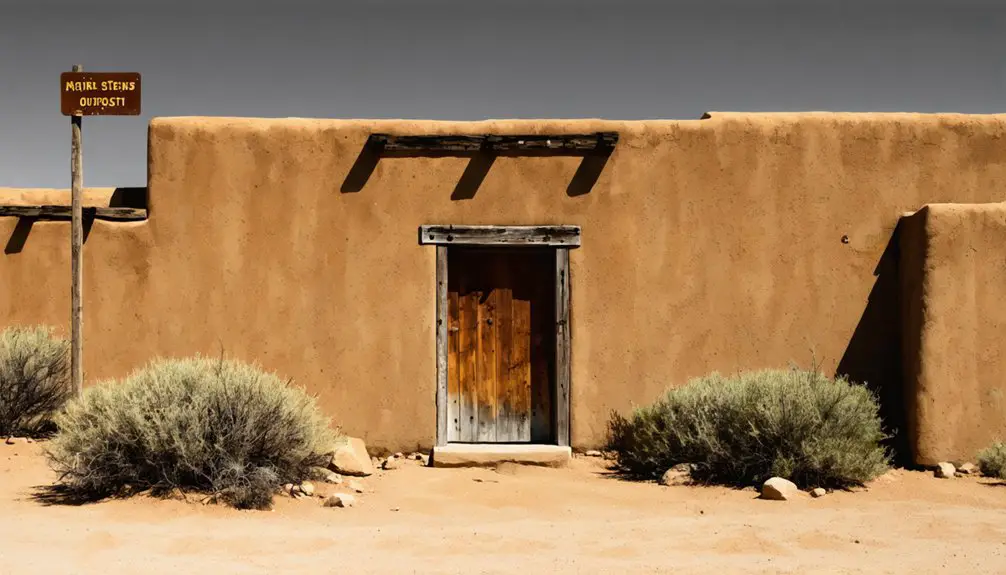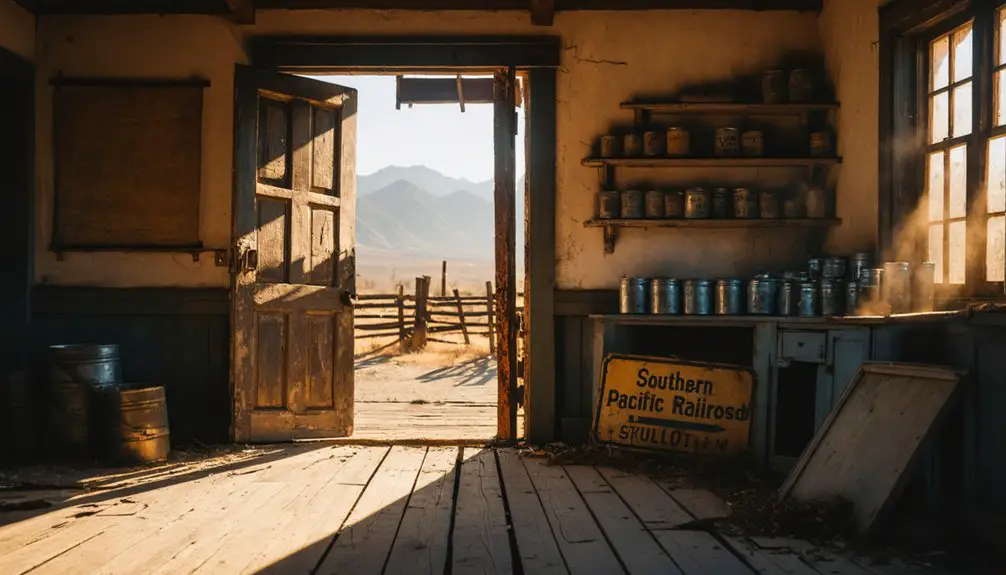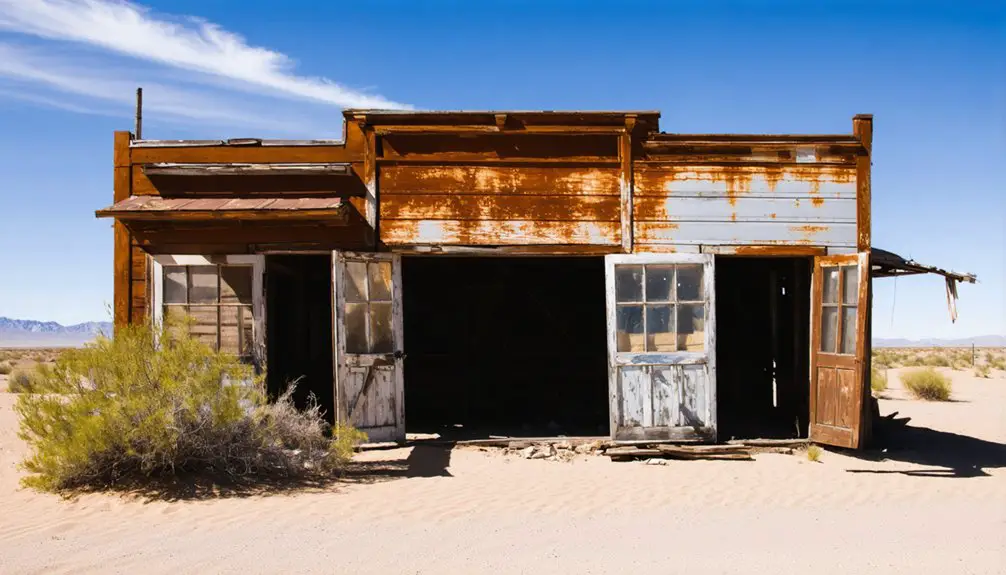You’ll find Steins in southern New Mexico’s desert landscape, where a once-thriving railroad town now stands frozen in time. Originally established as a Southern Pacific Railroad station in the 1870s, the town peaked at 1,000 residents in 1919 before declining after the quarry’s closure in 1925 and the railroad’s switch to diesel engines. Since 1988, preservationists have maintained the site’s authentic character, leaving original artifacts untouched. Steins’ weathered buildings and rusted remnants hold countless stories of America’s railroad frontier.
Key Takeaways
- Steins was established as a Southern Pacific Railroad station in the late 1870s, becoming a thriving hub with nearly 1,000 residents by 1919.
- The town’s economy relied on the railroad depot and nearby rock quarry until their closures in the 1940s and 1925, respectively.
- A devastating fire in 1964, combined with the railroad’s shift to diesel engines, led to the town’s abandonment and ghost town status.
- Larry Link purchased Steins in 1988, preserving authentic artifacts and allowing visitors to explore the genuine remains.
- Located in southern New Mexico, Steins served as a crucial water and fuel stop for steam locomotives along the “Sunset Route.”
The Legacy of Major Enoch Steen’s Expedition

While serving in the 1st U.S. Dragoons, Major Enoch Steen shaped the military landscape of southern New Mexico through his strategic operations against Apache raiders.
You’ll find his influence most evident in his 1849 military expeditions near the Santa Rita copper mines, where he led 50 cavalrymen in successful engagements that secured settler safety. In one notable engagement, he sustained combat injuries while defeating Mimbres Apache raiders on August 16th. Steen’s approach combined decisive military action with diplomatic finesse, as he became the first U.S. Army officer to negotiate peace treaties with Apache groups along the Gila River.
His leadership extended beyond combat, establishing Fort Buchanan near Sonoita Creek and coordinating with other commanders to maintain regional control.
Steen’s military prowess went beyond battlefield tactics as he strategically founded Fort Buchanan and fostered command relationships throughout the territory.
Through Apache negotiations and tactical operations, Steen’s actions laid the foundation for increased American military presence, ultimately influencing settlement patterns and security protocols across the southwestern frontier.
Life on the Southern Pacific Railroad Line
After the Southern Pacific Railroad established its transcontinental “Sunset Route” through southern New Mexico in 1881, you’d find a complex network of rail operations transforming the region’s economic and social landscape.
As you traveled these rails, you’d encounter a vibrant railroad culture centered around steam locomotives, water stops, and maintenance facilities in towns like Steins. The rail network extended into Mexico, where the Southern Pacific of Mexico operated 1,095 miles of track from Nogales to Guadalajara. Similar to the grade restrictions on other rail lines, the track was carefully engineered to maintain safe operations.
You’d witness freight trains hauling mining outputs, livestock, and agricultural goods, while passenger service connected you to major cities from Los Angeles to New Orleans.
In communities along the line, you’d see how the railroad provided employment through its depots, section houses, and maintenance operations.
The Southern Pacific’s strategic expansion through leasing and acquisitions meant you could access an extensive rail network that shaped the Southwest’s development and connected its resources to national markets.
Surviving the Harsh Desert Frontier
Despite the allure of frontier opportunities, you’d face formidable challenges surviving in Steins’ harsh desert environment. Your desert survival would depend on careful resource management of scarce water, with annual rainfall averaging only 12-14 inches.
You’d contend with dramatic temperature swings, from scorching 95°F summer days to frigid winter nights in the mid-teens. To endure these conditions, you’d need to construct shelter using thick adobe walls for insulation and position buildings strategically for shade. The region’s low relative humidity helped settlers tolerate extreme temperatures more comfortably than in humid climates. Climate projections suggest settlers would face even tougher conditions today, with temperature increases of up to 14.5°F possible this century.
You’d rely on drought-resistant vegetation for livestock grazing and learn to time your harvests with brief monsoon rains. Water conservation would become your daily priority, as high evaporation rates and extended droughts threaten wells and cisterns that sustain life in this unforgiving landscape.
From Railroad Hub to Abandonment
You’ll find that Steins’ transformation from a bustling railroad hub to an abandoned ghost town mirrors the economic trajectory of many Western frontier settlements, as its initial prosperity hinged entirely on Southern Pacific Railroad operations and the nearby quarry that employed thousands.
When the quarry closed in 1925 and water scarcity became an insurmountable challenge at $1.00 per barrel, the town’s fate was sealed by its complete dependence on railroad-delivered resources.
The exodus of residents accelerated after the post office closure in 1944, and a devastating fire in 1964 destroyed what remained of this once-thriving community of 1,000 people. The town’s notoriety was marked by the Black Jack Ketchum Gang robbery of the Southern Pacific Sunset Limited in 1897. In 1988, Larry and Linda Link purchased the property and began offering guided tours of the historic site to preserve its legacy.
Railroad’s Economic Impact
When the Southern Pacific Railroad established its station at Steins Pass in the late 1870s, the foundation was laid for what would become a thriving railroad hub.
You’ll find that railroad expansion transformed this remote location into a bustling community of nearly 1,000 residents by 1919, demonstrating remarkable economic resilience through its peak years.
The town’s prosperity directly connected to the railroad’s operational needs, with the nearby rock quarry providing substantial employment.
You’d have encountered a vibrant commercial district featuring hotels, saloons, boarding houses, and a mercantile, all sustained by railroad activity.
Multiple services emerged to support both permanent residents and transient railroad workers, creating a self-sustaining economy.
The railroad’s presence assured regular mail service, passenger traffic, and essential water delivery, cementing Steins’ role as a significant transportation center.
Over one thousand Chinese laborers worked in the area during the railroad’s construction phase in 1878, contributing significantly to the town’s early development.
The town faced its ultimate decline when water scarcity forced residents to rely completely on railroad deliveries for their water supply.
Water Scarcity Challenges
Although the railroad transformed Steins into a bustling hub, the town’s greatest vulnerability lay in its complete dependence on imported water. You’d find no natural water sources in this harsh desert region, where the rocky terrain made well-digging nearly impossible.
Unlike other New Mexican settlements that developed sophisticated irrigation practices, Steins relied entirely on water transportation via rail, costing residents up to $1.00 per barrel.
The town’s fate was sealed when Southern Pacific Railroad ceased water deliveries after World War II. While you might’ve attempted rainwater collection, the arid climate offered minimal precipitation, making such efforts futile. After Southern Pacific’s diesel transition in 1945, the reduced workforce and water needs accelerated the town’s decline.
The water scarcity wasn’t unique to Steins – the entire region struggled with resource competition, leading to diplomatic tensions between the U.S. and Mexico over Rio Grande water rights.
Population Exodus Patterns
The story of Steins’ population exodus mirrors its water struggles, unfolding as a textbook case of boom-and-bust railway economics.
You’ll find distinct population decline patterns emerging from Steins’ peak of 1,000 residents in 1919 to its eventual abandonment, triggered by a series of economic blows.
The migration trends followed a predictable sequence: first, the quarry’s closure in 1925 pushed out dozens of workers.
Then, when Southern Pacific switched to diesel engines in the 1940s, you’d see the depot’s closure forcing more residents to seek opportunities elsewhere.
The final exodus accelerated after a devastating fire in 1964, which destroyed much of what remained.
Without water, jobs, or railroad support, even the most resilient residents couldn’t justify staying in this once-bustling railway hub.
The Links’ Vision for Preservation
In 1988, Larry Link’s purchase of Steins marked a pivotal shift in the ghost town’s preservation philosophy.
You’ll find his vision focused on authentic artifact conservation rather than theatrical recreations. The Links preserved the town’s genuine character by maintaining original items in their found locations, from mason jars to peacock feathers, allowing you to experience history untouched.
- Walk freely through cleared pathways that invite your personal discovery
- Discover artifacts exactly where time left them, telling their own stories
- Experience the raw authenticity of an untamed Western settlement
- Connect with history without the distraction of costumed interpretations
- Explore at your own pace, guided by your curiosity rather than scripted tours
The Links’ approach revolutionized the visitor experience by letting you engage directly with Steins’ historical remnants, fostering a deeper appreciation for its cultural significance.
A Testament to Southwestern Railroad Heritage

While preservation efforts keep Steins’ history alive today, its foundational identity emerged from the thundering steam locomotives that once ruled the Southwest.
You’ll find evidence of authentic railroad culture in every aspect of this former community, from its origins as a crucial fueling stop to the massive rock quarry that supplied ballast for the tracks.
The town’s resilience shines through its 1,000-resident peak in 1919, when it supported a vibrant mix of services despite harsh desert conditions and external threats.
In spite of adversity, Steins’ vibrant community of 1,000 souls thrived in 1919, carving out a spirited existence in the harsh desert.
Community resilience manifested in the establishment of essential amenities like the post office and various social establishments.
Though Chinese laborers faced discrimination, their significant contribution to laying gravel beds near Steins Peak helped forge a critical link in the rail connection between California and the Gulf of Mexico.
Frequently Asked Questions
What Happened to the Chinese Laborers After the Railroad Work Ended?
You won’t find much Chinese integration after railroad work ended – most laborers dispersed to unknown locations, their labor legacy fading as they sought opportunities elsewhere, with minimal records of their subsequent lives.
Were There Any Notable Shootouts or Train Robberies in Steins?
Despite its location along 1880s outlaw routes, you won’t find documented shootouts or train robberies specifically in Steins. While regional Apache conflicts and bandit activity occurred nearby, the town lacks confirmed violent incidents.
How Did Residents Get Food Supplies in Such an Isolated Location?
You’d rely on trading routes through the Southern Pacific Railroad’s station and supply wagons from stagecoaches to obtain essential provisions, with local stores stockpiling non-perishable goods between deliveries.
What Remains of the Original Stone Quarry and Crushing Plant Today?
You’ll find a vast wasteland of forgotten industry, where scattered rock piles, deteriorating stone structures, and rusted machinery tell the quarry’s story. Minimal preservation efforts mean these remnants continue crumbling into history.
Did Any Famous Outlaws or Historical Figures Pass Through Steins?
You’ll find that Major Enoch Steen stands out as the most significant historical figure, while records don’t conclusively identify any famous outlaws, though many likely passed through this dangerous borderland territory.
References
- https://cityofdust.blogspot.com/2014/02/troubled-times-steins-new-mexico.html
- https://southernarizonaguide.com/steins-ghost-town/
- https://www.gypsyjournalrv.com/2020/03/modern-day-ghost-town-mystery/
- http://www.colleenkinder.com/steins
- https://www.youtube.com/watch?v=Bl4Is9Myqqc
- http://www.donaanacountyhistsoc.org/HistoricalReview/2000/HistoricalReview2000.pdf
- https://digitalrepository.unm.edu/cgi/viewcontent.cgi?article=1223&context=nmhr
- https://santacruzheritage.org/wp-content/uploads/2021/12/Military-Posts-on-the-Border-1.pdf
- https://en.wikipedia.org/wiki/Enoch_Steen
- https://digitalrepository.unm.edu/cgi/viewcontent.cgi?article=1973&context=nmhr



